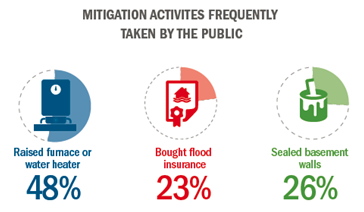Since 2010, the Federal Emergency Management Agency (FEMA) has conducted an annual nationwide study of flood risk awareness* among U.S. households. Data from this survey is used to improve FEMA’s general understanding of flood risk perceptions, inform community engagement strategies, and evaluate the Risk Mapping Assessment Planning (Risk MAP) program’s progress in the identification, mitigation, and communication of risk. The survey is from 2013, authorized by the U.S. Office of Management and Budget: Control No. 1090-0007.This page is intended for home, property, and business owners and other community members interested in better understanding their local flood risk.
Research Objectives
The survey was designed to determine the general population’s:
- Awareness of flood risk
- Knowledge of specific ways to mitigate flood risk
- Perception of barriers to mitigation activities
- Understanding of steps taken to reduce risks
Research findings will be used to inform and refine Risk MAP’s national outreach and community engagement strategies and will be shared across FEMA and other Federal agencies that address common issues.
Research Methodology
- A total of 1,022 telephone interviews were conducted between June 3 and August 6, 2013.
- Interviews were administered by random digit dial to households in the U.S. within FEMA’s 10 Regions.
- The sample was comprised of 25% cell phone users and 75% landline users.
- A minimum of 100 respondents were surveyed in each Region.
- The majority of respondents (77%) were homeowners.
Key findings from the survey are provided below.
Risk Awareness
- Three out of 10 individuals believe their community is at risk of flooding. Since the first annual survey was conducted in 2010, awareness of flood risk among the general population of survey respondents has consistently remained between 30% and 40%.
- Fewer than one in 10 respondents characterized their community as having a “high” risk of flooding.
- Few Americans surveyed believe that their home is at risk of flooding. When asked, 10% of survey respondents said they believed their residences were at risk.
- Residents of Risk MAP communities expressed a greater awareness of flood risk.

Mitigation
 Despite the relatively low levels of perceived flood risk, seven out of 10 respondents reported taking at least one form of hazard risk mitigation action.
Despite the relatively low levels of perceived flood risk, seven out of 10 respondents reported taking at least one form of hazard risk mitigation action.
Of the respondents who acted to reduce their risk, safety for themselves and their families was the most commonly cited reason. Other reasons for taking action included having been previously impacted by a disaster (13%) and “doing the right thing” (11%).- The majority of respondents who did not reduce their hazard risk decided not to act because they did not believe their homes were at risk. Of the 294 respondents who did not take any mitigation actions, 72% did not believe their primary residence was at risk, 14% believed they could not afford the cost of taking action, and 4% were not sure of what actions to take. The remaining 10% were “other.” Among this same group of respondents, 19% indicated that they intended to take mitigation action in the year ahead.
Communication
- People overwhelmingly prefer local media as a source of information about flood risk in general. Eight out of 10 survey respondents identified “local media” (e.g., newspapers, TV, radio) as one of the top three ways they would like to receive information about flood risk.
- One in four survey respondents reported looking for flood risk information. A recent move to a new residence was the single most commonly cited driver for this result.
- Frequent flood risk communication is associated with greater flood risk awareness. Whether it is because local officials in these communities are communicating more frequently or simply doing so in a more memorable fashion, survey respondents who believed their community was at risk of flooding were more likely to report hearing about flood risk from their local officials at least once a year (52% of aware respondents vs. 23% of unaware respondents).

Additional Information
- A similar 2013 survey was conducted with local officials
- To download general population survey results from past years, click the years below:
*While these statistics are taken directly from the survey, the interpretation shown is the opinion of FEMA.
